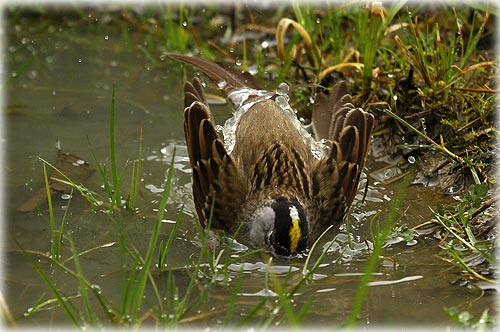
New technology tracks sparrow migration for first time from California to Alaska
April 26, 2012
During a time when birds are experiencing the negative impacts of climate and land-use changes, being able to pinpoint the most important breeding and stopover places is critical to prioritizing conservation investments.
This Golden-crowned Sparrow was photographed in the Herring Cove area south of Ketchikan, Alaska (May 2011) while delighting in a dip in a bird bath provided by Mother Nature.
"This study is helping to unravel the mystery of bird migration and answer the age-old question of where birds go, which helps protect habitat along their entire migratory journey," said lead author, PRBO's Dr. Nat Seavy. Each bird, which weighs approximately 30 grams, migrated from 1600 to 2400 miles one-way to their breeding grounds. Their individual breeding locations spanned approximately 750 miles along the coast of Alaska, and their north migration averaged only 29 days while southbound migration averaged nearly twice that (53 days). "Until now, all we knew was that these birds bred far to the north and undertook one of the longest migrations of all songbirds that winter in central California. We're very excited to finally pinpoint exactly where some of our Golden-crowned Sparrows breed," explained Diana Humple, PRBO's Palomarin Field Station Manager and a co-author of the study. Operating since 1966, PRBO's Palomarin Field Station has been one of the premier west-coast locations for long-term studies on birds and their habitats. These data sets that extend over several decades allow scientists to assess human-caused and natural changes over time to guide conservation action. The breeding locations for the four birds included areas of Katmai National Park, Wrangell-St. Elias National Park, and the Chugach National Forest. "Today we are facing unprecedented changes in land-use and our climate" explained Nat Seavy. "The information in this study will help us understand where our migratory birds may be vulnerable to these changes, and what we can do to help protect them and the ecosystems on which they—and we—depend."
On the Web:
Source of News:
E-mail your news &
photos to editor@sitnews.us
|
||
